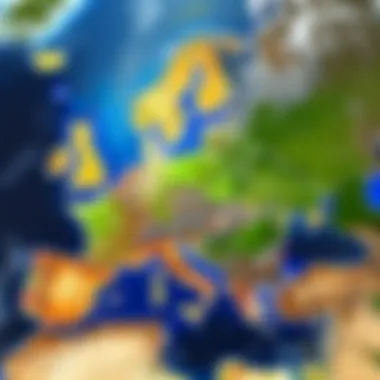The Importance of European Server Locations for Blizzard Games


Intro
In the realm of online gaming, the significance of server locations often gets overshadowed by flashy graphics or immersive storylines. Yet, for players engaging in Blizzard games, these server locations, especially across Europe, carry a weighty importance. From latency issues that can dictate the outcome of a match to the feeling of community that servers help foster, understanding the implications of server placement is essential for both players and developers alike.
This article aims to navigate through the nuanced landscape of European server locations, shedding light on how they influence gameplay, community engagement, and the overall experience for gamers. By examining data centers, regional variations, and potential challenges, we can paint a clearer picture of why these factors truly matter.
In essence, the conversation about server locations isn’t just about technicalities; it’s about creating a richer gaming experience that resonates with players. With the ever-evolving nature of online gaming, particularly in a landscape constantly shaped by Blizzard’s ongoing updates and community activities, a deep dive into this subject is not merely informative but crucial for anyone invested in gaming culture.
So, let’s embark on this journey to explore the world of server locations in Europe for Blizzard games, kicking things off with the latest game updates and how they intertwine with server functionalities.
The Role of Servers in Online Gaming
In the vast universe of online gaming, servers act as the backbone that supports everything from real-time interactions to the ultimate gaming experiences. For players immersed in Blizzard games, the significance of server locations emerges not just as a technical detail but as a pivotal aspect that defines playability and engagement.
Understanding Game Servers
At its core, a game server is a specialized computer or network of computers that hosts multiplayer game sessions. This setup enables players to connect, interact, and compete within a virtual environment, providing an arena for action, strategy, and camaraderie. Think of it like the conductor of a well-orchestrated symphony; without it, the music just falls out of harmony.
Different types of servers exist, including dedicated servers, where resources are solely allocated for a single game, and peer-to-peer configurations, where player connections facilitate the game. Each type has its pros and cons, yet the choice ultimately hinges on the desired gaming experience. In relation to Blizzard's offerings like World of Warcraft, Overwatch, and Hearthstone, dedicated servers serve as the preferred method. They ensure stability, support for numerous players, and just the right amount of server power to handle spikes in activity.
Importance of Low Latency
One term that gets tossed around in gaming discussions is “latency.” In layman's terms, latency refers to the time it takes for data to travel between your device and the game server. Low latency means swift interactions, while high latency can turn an intense gaming session into a frustrating ordeal filled with delays and stuttering actions.
To put it simply, you're dealing with a scenario where your hits miss just because the server is lagging behind, prompting a slow response despite your reflexes being spot on. The ideal situation is to have a gaming server located nearby. For instance, if you're gaming in Germany, connecting to a server across the ocean in the U.S. won’t cut it unless you fancy a serious delay.
"Low latency is akin to the difference between a smooth ride on a freshly paved road versus navigating potholes—one experience is exhilarating, while the other is just frustrating."
A sustainable, low-latency connection greatly influences a player's ability to perform well, communicate effectively, and maintain an edge during competitive play. Blizzard games, given their intricate mechanics and often competitive nature, demand low-latency environments for an optimal player experience.
To draw the picture clearly, a gamer’s experience can be viewed through these focused points:
- Server Proximity: The closer the server, the lower the latency and better the performance.
- Data Transfer Rate: Efficient data handling ensures smoother gameplay without hiccups.
- Infrastructure: Reliable hardware ensures servers can handle concurrent player activities without crashing.
When stepping into the realm of online gaming, especially for enthusiasts of Blizzard titles, understanding the role servers play becomes crucial. It shapes not just how games are played but also how connected players feel—transforming gameplay from a simple pastime into a shared experience within vibrant virtual communities.
Overview of European Server Structure
Understanding the landscape of server locations in Europe is vital for players who immerse themselves in Blizzard games. This section highlights not only how geographical nuances affect gameplay but also how the structure of servers can optimize user experience. In a realm where every millisecond counts, the distribution of servers across various regions can mean the difference between a seamless gaming session and frustrating lag due to poor connectivity.
The presence of multiple servers allows for several benefits:
- Improved Latency: Closer proximity means lower latency, which is crucial for fast-paced games like Overwatch or Hearthstone. Players can react without delay, keeping the gameplay immersive and responsive.
- Resource Allocation: Different geographical servers can distribute traffic effectively, meaning no single server gets overwhelmed. This is especially important during peak gaming hours.
- Enhanced Experience: For community-driven games, localized servers foster better interactions among players from the same regions, enhancing teamwork and communication.
With these aspects in mind, let's delve deeper into specific factors that shape the server environment.


Geographical Considerations
Europe's unique geographical features significantly influence where servers are established. With a rich tapestry of countries and cultures, online gaming must consider factors like population density, infrastructure quality, and regional preferences. The distribution of data centers across Europe isn’t merely a logistical decision; it’s a strategic move to bolster game accessibility and performance.
Some key takeaways include:
- Centralized Locations: Countries like Germany and the Netherlands serve as hubs due to their advanced digital infrastructure. High-speed internet availability is a critical factor that ensures minimal latency for many players.
- Decentralization: To combat network congestion, Blizzard also invests in diversifying server locations across Eastern and Western Europe, making it easier for players to connect to a nearby server regardless of their geographical coordinates.
- Local Trends: Certain games may have varying popularity in different regions, necessitating an understanding of player distribution to cater to specific gaming preferences.
By mapping these geographical considerations, Blizzard can provide a streamlined and robust gaming experience that resonates well with its European audience.
Key Data Centers
The backbone of online gaming lies in its data centers, and Europe is no stranger to sophisticated infrastructure. Knowledge of the primary data centers that host Blizzard games is essential for understanding their reliability and efficiency.
Among the notable data centers are:
- Frankfurt, Germany: Often cited for its advanced technological facilities and robust connectivity. This city is a pivotal node in Blizzard’s network, giving a multitude of players from surrounding regions quick access to games with low latency.
- Amsterdam, Netherlands: Another key location, Amsterdam benefits from strategic positioning that allows excellent data flow across Europe. This city supports a diverse range of games, from multiplayer arenas to turn-based strategy games, making it a versatile hub for operations.
- Paris, France: Hosting a number of Blizzard servers, Paris not only serves local gamers but also communities from Southern Europe, providing essential coverage for online activities.
These data centers are not merely large buildings. They are fortified fortresses, built with state-of-the-art security measures, ensuring that gameplay remains uninterrupted and information is protected.
Through a combination of strategic geographical placement and cutting-edge technology, Blizzard fortifies its commitment to an exceptional gaming environment, allowing players to dive headfirst into their favorite universes without a hitch.
Server Locations and Game Performance
When it comes to online gaming, specifically for Blizzard titles, the layout and positioning of servers become crucial to the player's experience. The connection between server locations in Europe and game performance isn't just a matter of technical preference—it's about the subtleties that can mean the difference between easy gameplay and sudden interruptions.
Latency Impacts
Latency refers to the delay that occurs in data transmission. For gamers, a low latency rate often translates to smoother and more responsive gameplay. If you’re playing a game like Overwatch or World of Warcraft, high latency can lead to frustrating moments, like characters moving in jerky motions or actions taking longer to register.
The ideal setup is to have game servers located as close as possible to the players. For instance, if you're in the UK and connecting to a server located in Eastern Europe, you might experience high latency that can muck up your ranking progress in competitive matches. Furthermore, with various European countries having unique internet infrastructures and access speeds, player experiences can vary greatly depending on which server they choose.
Regional Load Balancing
Regional load balancing is another vital aspect of server performance. If a game experiences a high number of players in a particular area, then the server can become overloaded. This can lead to slow load times and increased lag—a real buzzkill when you're trying to level up or engage in a heated team battle.
Smart server management mitigates this by distributing players across multiple servers based on their geographical region. This means more consistent and reliable performance. For example, while players in central Europe may be funneled into a server in Germany, those on the edges, like in Portugal or Finland, could experience better gameplay connected to their nearer servers.
Another advantage of effective load balancing is reducing the chances of server downtime. By having multiple servers prepared to shoulder the load, if one experiences technical difficulties, other servers can keep the show running without a hitch.
Server Downtime and Its Effects
Server downtime—an unfortunate reality for many online games—can wreak havoc on the gaming experience. For a die-hard player, a sudden outage might feel like a punch to the gut. When servers go down, it’s not just a matter of frustration, especially during peak gaming hours; players may lose game progress or valuable in-game items.
Consider Blizzard titles that foster dedicated communities. If servers are consistently unreliable, players might begin to stray towards other games, causing the overall player base to dwindle. As a result, game developers face the uphill task of maintaining player engagement while ensuring their back-end infrastructure is robust enough to handle demand fluctuations.
"Solid server infrastructure isn’t just a necessity; it’s the backbone of multiplayer gaming. A few minutes offline can seem like an eternity to dedicated players."


For more insights on server infrastructure, visit Wikipedia or check out gaming forums on Reddit.
Understanding server performance can greatly enhance your overall gaming experience.
Community Engagement and Servers
In the realm of online gaming, community engagement stands as a cornerstone, particularly for players inhabiting the diverse landscapes of Blizzard games. The way players interact with each other, how they forge friendships, and engage in cooperative or competitive play hinges greatly on the location of game servers. It's not just about ping rates and connection speeds; it's about creating an environment where players can thrive together.
Regional Player Dynamics
Regional player dynamics greatly influence the social fabric of online gaming communities. With a vast array of players spread across countries in Europe, each region fosters unique cultural nuances and gaming styles. For instance, players from Germany might approach strategy games like Overwatch with a meticulous planning mindset, whereas those from Spain may prioritize aggression and adaptability. This variety can create richer in-game experiences where players learn from one another, broadening horizons through different playing styles.
Moreover, server location directly impacts regional matchmaking. Players in the same vicinity get matched more frequently, fostering familiarity and possibly leading to friendships outside the game. A community-centric server can make a world of difference, providing low latency not just for gameplay but also for the social interactions that ensue.
- Localized Play: Players originating from similar areas often enjoy a sense of camaraderie.
- Cultural Exchange: Diverse communication styles contribute to richer gaming experiences.
Communicating Across Borders
Blizzard has always touted its emphasis on community. Servers facilitate direct communication channels, enabling players from varying geographical regions to connect seamlessly. This cross-border interaction can be a double-edged sword, though. On one hand, it opens up a wealth of perspectives and playstyles. On the other, differing languages and cultural references can sometimes lead to misunderstandings in chat rooms or voice calls.
Gaming platforms now integrate translation tools or options for players to communicate more effectively, reducing the friction caused by language barriers. Blizzard games have non-trivial chat systems that support emoticons and even built-in translations in World of Warcraft to aid interactions amongst global players.
"Communication can make or break a team. Knowing how to navigate different communication styles is essential for success, especially when collaborating with a geographically diverse team."
In essence, server locations do not only affect performance but shape the interactive space in which players find themselves. The values of teamwork, collaboration, and cultural appreciation can all coalesce to create a gaming atmosphere that is both immersive and engaging.
Realizing this potential requires both the players’ willingness to connect across borders and the robustness of the platform itself. For fans of Blizzard titles, acknowledging these dynamics can enhance their gameplay experience significantly.
Security and Compliance
In a world where data breaches and cyberattacks seem to be a daily headline, the significance of security and compliance can't be overstated, especially for gamers immersed in the vast universes crafted by Blizzard. Trust is paramount. Players expect not only a seamless gaming experience but also peace of mind regarding the safety of their personal information. Ultimately, robust security measures and strict compliance regulations play pivotal roles in safeguarding sensitive data and ensuring smooth operational continuity.
Data Protection Regulations
The European Union has set up rigorous data protection frameworks, notably the General Data Protection Regulation (GDPR). This legislation acts as a shield for players, mandating that gaming companies handle personal data with the utmost care and transparency. Blizzard Games, in operating within Europe, must ensure compliance with these regulations to avoid heavy fines and foster player trust.
Key aspects of GDPR compliance for Blizzard include:
- Transparency: Gamers have the right to understand how their data is used, stored, and shared. Blizzard must provide clear information regarding data collection methods.
- Data Minimization: Only necessary information should be collected from players, ensuring that players' personal details are not misused or unnecessarily exposed.
- User Consent: For any data processing, explicit gamer consent is mandatory. This not only protects players but also bolsters Blizzard's reputation as a responsible company.
These regulations play a significant role in shaping server operations in Europe. By complying with such rules, Blizzard can enhance its image and ensure that gamers feel secure while enjoying their favorite titles.
Cybersecurity Measures
The protection of player data goes beyond mere compliance with regulations. It requires layered cybersecurity measures that act like fortresses against potential threats. Blizzard’s European servers incorporate sophisticated technologies to keep player information safe and secure.
Some of the vital cybersecurity measures in practice include:


- Encryption: This process protects data at rest and in transit by converting it into a secure format. This means even if attackers gain access to the data, it remains unreadable without proper decryption keys.
- Firewalls and Intrusion Detection Systems: These tools monitor and protect the network, identifying and mitigating potential threats in real time.
- Regular Security Audits: Blizzard conducts frequent assessments of their systems to identify vulnerabilities. This proactive approach not only safeguards data but also helps maintain compliance with regulations.
- Employee Training: Engaging staff with cyber-awareness programs is critical. A well-informed team is the first line of defense against social engineering attacks that could compromise security.
"In this digital age, adopting a mindset of proactive vigilance is essential for both companies and their users."
By strengthening their cybersecurity framework, Blizzard not only aligns with legal obligations but also cultivates a trustworthy environment for gamers, encouraging long-term engagement and loyalty.
In summary, a robust focus on security and compliance ensures that players can engage deeply with Blizzard's offerings without the looming anxiety of data misuse or cyberthreats.
Future of Servers in Europe
The landscape of online gaming, particularly for Blizzard games, is rapidly evolving, with server locations in Europe an integral part of that change. As technology advances, players are keen to understand how these developments influence their gameplay experience. The future of servers in Europe is crucial, not just for enhancing player engagement but also for maintaining competitive edges in a global gaming arena.
In the face of increasing demand for seamless connectivity, understanding how servers adapt to future challenges becomes paramount. With better server technologies, players can expect faster response times and more reliable connections. This evolution shapes not only the game-centric experience but also the gaming community itself.
Advancements in Technology
Technological innovations are at the heart of the evolution of server infrastructures. One striking example is the shift toward cloud-based solutions. Traditional on-premises servers tend to face limitations in terms of scalability and performance. In contrast, cloud services like Amazon Web Services or Microsoft Azure allow for more adaptive resources. This means that during peak times, when player activity spikes, the infrastructure can adjust accordingly without significant downtime or lag.
Furthermore, the introduction of edge computing offers remarkable potential. It pushes data processing closer to the user, effectively reducing latency. For Blizzard players in Europe, this could translate to smoother gameplay in titles like World of Warcraft or Overwatch, where every millisecond matters. Moreover, advancements in artificial intelligence enhance server management and optimize load balancing, ensuring that players receive an equitable experience regardless of their region.
- Benefits of Edge Computing:
- Reduces distance data must travel, lowering latency.
- Enables faster updates and server responses.
- Improves player experience significantly during high-traffic events.
Scalability Considerations
As the player base for Blizzard’s games continues to grow, scalability becomes a pressing concern. The need for servers that can efficiently handle increasing loads is not merely about capacity; it’s about responsiveness in high-stress situations, like game launches or in-game events.
A practical consideration for the future is the ability to upscale server capabilities in real-time without interrupting service. This can be facilitated through virtualization technologies, allowing for flexible allocation of server resources.
Moreover, Blizzard’s commitment to global reach must consider local European markets. The ability to deploy additional servers quickly can provide local players with optimal experiences, reducing lag and enhancing cooperative gameplay.
Ultimately, the success of server scalability lies in anticipating future growth. The gaming industry is dynamic; hence, server solutions must be agile enough to adapt to new trends, including emerging technologies and changing player behaviors.
In summary, as the future of servers in Europe unfolds, technological advancements and scalability considerations will shape how gamers interact with their favorite Blizzard titles. The potential benefits are steep, offering both immediate performance gains and long-term community engagement, which are invaluable in today’s competitive gaming market.
The End: The Impact of Server Location on Gameplay
When thinking about online gaming, especially within the realm of Blizzard games, server location is often brushed aside. Yet, it is a factor that plays a pivotal role not only in gameplay experiences but also in shaping player interactions and community dynamics. Understanding the significance of server locations in Europe provides clarity, particularly for fans who deeply appreciate the nuances of performance and connectivity.
Summarizing Key Insights
- Latency Matters: The distance between the player and the server influences the time it takes for actions to register in the game. A closer server typically translates to lower latency, creating a smoother gameplay experience. For example, players in Germany connecting to a server in Frankfurt will experience less lag than those connecting to one in London.
- Localization Enhances Community: Geographic servers foster a sense of regional identity among players. This is especially notable in games where teamwork is crucial. By clustering players from similar areas or languages, Blizzard games benefit from more coordinated efforts, leading to enhanced performance during multiplayer engagements.
- Data Centers' Role: Blizzard has strategically placed data centers across Europe to optimize gameplay. Each center contributes uniquely to data processing capabilities, enhancing efficiency and improving server response times. This setup is vital for handling the surges in player activity, keeping the gaming experience seamless.
- Security and Compliance: The data exchange between servers and players must adhere to regulations such as GDPR in Europe. Proper server locations not only ensure compliance but also enhance data protection measures—essentially safeguarding sensitive player information.
"The location of servers dictates more than just connection speed; it can alter the entire experience and how players interact with each other and the game."
Considerations for Future Players
As gaming continues to evolve, players must keep certain factors in mind regarding server locations:
- Research Before Joining: Knowing where your server is located can significantly impact your gaming experience. Areas with multiple servers may provide options with lower latency for new players.
- Future Trends in Server Technology: Stay informed about changes in server technology. Innovations such as edge computing can potentially alter server performance, promising even more efficient connections.
- Community Engagement: Joining local servers not only improves gameplay but also fosters unique community relationships. Engaging with local players can lead to forming friendships and participating in organized playing events.
- Be Aware of Updates: Blizzard frequently updates their servers. Keeping an eye on these changes helps players adapt and adjust proactively, ensuring a smooth transition during gameplay.
In summary, server locations are far more than mere technical details in the world of online gaming. They form the backbone of the gameplay experience, influencing everything from latency to community interactions. Gamers must appreciate the profound impact server choice has, not just for their immediate gameplay, but also for the broader experiences that define gaming culture.



